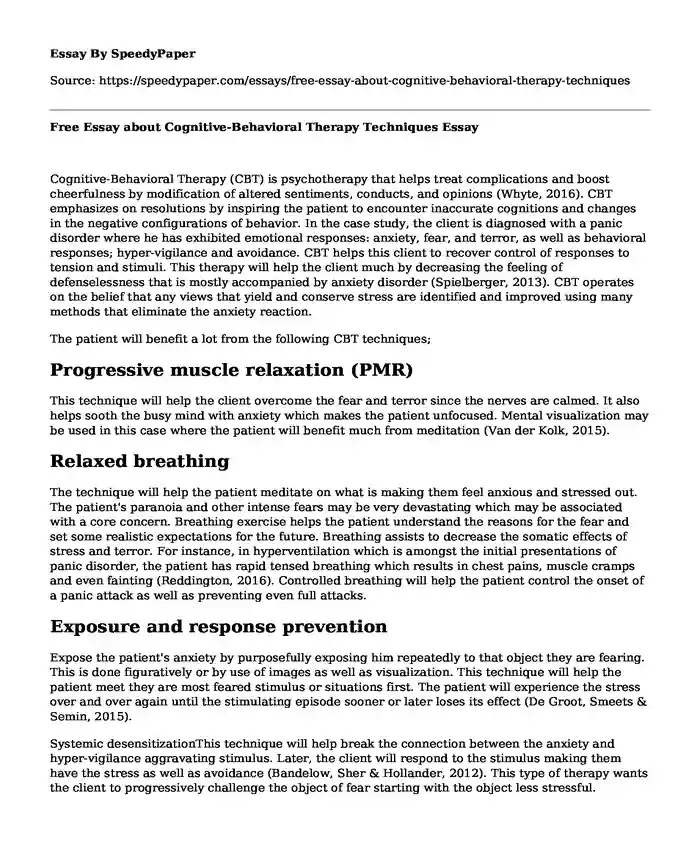
| Type of paper: | Report |
| Categories: | Psychology Counseling Behavior change |
| Pages: | 3 |
| Wordcount: | 622 words |
Cognitive-Behavioral Therapy (CBT) is psychotherapy that helps treat complications and boost cheerfulness by modification of altered sentiments, conducts, and opinions (Whyte, 2016). CBT emphasizes on resolutions by inspiring the patient to encounter inaccurate cognitions and changes in the negative configurations of behavior. In the case study, the client is diagnosed with a panic disorder where he has exhibited emotional responses: anxiety, fear, and terror, as well as behavioral responses; hyper-vigilance and avoidance. CBT helps this client to recover control of responses to tension and stimuli. This therapy will help the client much by decreasing the feeling of defenselessness that is mostly accompanied by anxiety disorder (Spielberger, 2013). CBT operates on the belief that any views that yield and conserve stress are identified and improved using many methods that eliminate the anxiety reaction.
The patient will benefit a lot from the following CBT techniques;
Progressive muscle relaxation (PMR)
This technique will help the client overcome the fear and terror since the nerves are calmed. It also helps sooth the busy mind with anxiety which makes the patient unfocused. Mental visualization may be used in this case where the patient will benefit much from meditation (Van der Kolk, 2015).
Relaxed breathing
The technique will help the patient meditate on what is making them feel anxious and stressed out. The patient's paranoia and other intense fears may be very devastating which may be associated with a core concern. Breathing exercise helps the patient understand the reasons for the fear and set some realistic expectations for the future. Breathing assists to decrease the somatic effects of stress and terror. For instance, in hyperventilation which is amongst the initial presentations of panic disorder, the patient has rapid tensed breathing which results in chest pains, muscle cramps and even fainting (Reddington, 2016). Controlled breathing will help the patient control the onset of a panic attack as well as preventing even full attacks.
Exposure and response prevention
Expose the patient's anxiety by purposefully exposing him repeatedly to that object they are fearing. This is done figuratively or by use of images as well as visualization. This technique will help the patient meet they are most feared stimulus or situations first. The patient will experience the stress over and over again until the stimulating episode sooner or later loses its effect (De Groot, Smeets & Semin, 2015).
Systemic desensitizationThis technique will help break the connection between the anxiety and hyper-vigilance aggravating stimulus. Later, the client will respond to the stimulus making them have the stress as well as avoidance (Bandelow, Sher & Hollander, 2012). This type of therapy wants the client to progressively challenge the object of fear starting with the object less stressful.
References
Bandelow B, Sher L, Bunevicius R, Hollander E, Kasper S, Zohar J, et al., (2012). Guidelines for the pharmacological treatment of anxiety disorders, obsessive-compulsive disorder and posttraumatic stress disorder in primary care. Int J Psychiatry Clin Pract, 16(2), 77-84.
De Groot, J. H. B., Smeets, M. A. M. & Semin, G. R. (2015). Rapid stress system drives chemical transfer of fear from sender to receiver. PLoS ONE, 10(2): e0118211. doi:10.1371/journal.pone.0118211.
Reddington, S, (2016). Self Help CBT Therapy Training Course: Cognitive Behavioral Therapy Toolbox for Anger Management, Depression, Anxiety, OCD, Sleep Disorders, Addictions and more...: Cognitive Behavioral Therapy Toolbox for Anger Management, Depression, Anxiety, OCD, Sleep Disorders, Addictions and more. JNR via Publish Drive. 60. Print.
Spielberger, C, (2013). Anxiety and Behavior. Elsevier Science. 430. Print. Retrieved from: https://books.google.co.ke/books?isbn=148325836X
Van der Kolk, B, (2015). The Body Keeps the Score: Mind, Brain, and Body in the Transformation of Trauma. Penguin Books. 464. Print. Retrieved from: https://books.google.co.ke/books?isbn=0141978619
Whyte, C, (2016). Cognitive Behavioral Therapy (CBT): 9 Powerful Techniques to Cure Negative Thoughts, Anxiety and Depression. Create Space Independent Publishing Platform. 62. Print.
Cite this page
Free Essay about Cognitive-Behavioral Therapy Techniques. (2022, Mar 09). Retrieved from https://speedypaper.net/essays/free-essay-about-cognitive-behavioral-therapy-techniques
Request Removal
If you are the original author of this essay and no longer wish to have it published on the SpeedyPaper website, please click below to request its removal:
- Free Essay on Globalization Effect
- Free Essay on Women Empowerment in The Yellow Wallpaper
- Essay Sample for Students: Blacks Representation in Media
- Free Essay on the Advertising Campaign for Inpera Hybrid Timepieces Collection
- Research Proposal Paper Sample: Implementation Plan for Evidence-Based Practice
- Drug Abuse as a Social Problem, Free Essay for Everyone
- Paper Example: Lessons Learned in Navajo land
Popular categories




